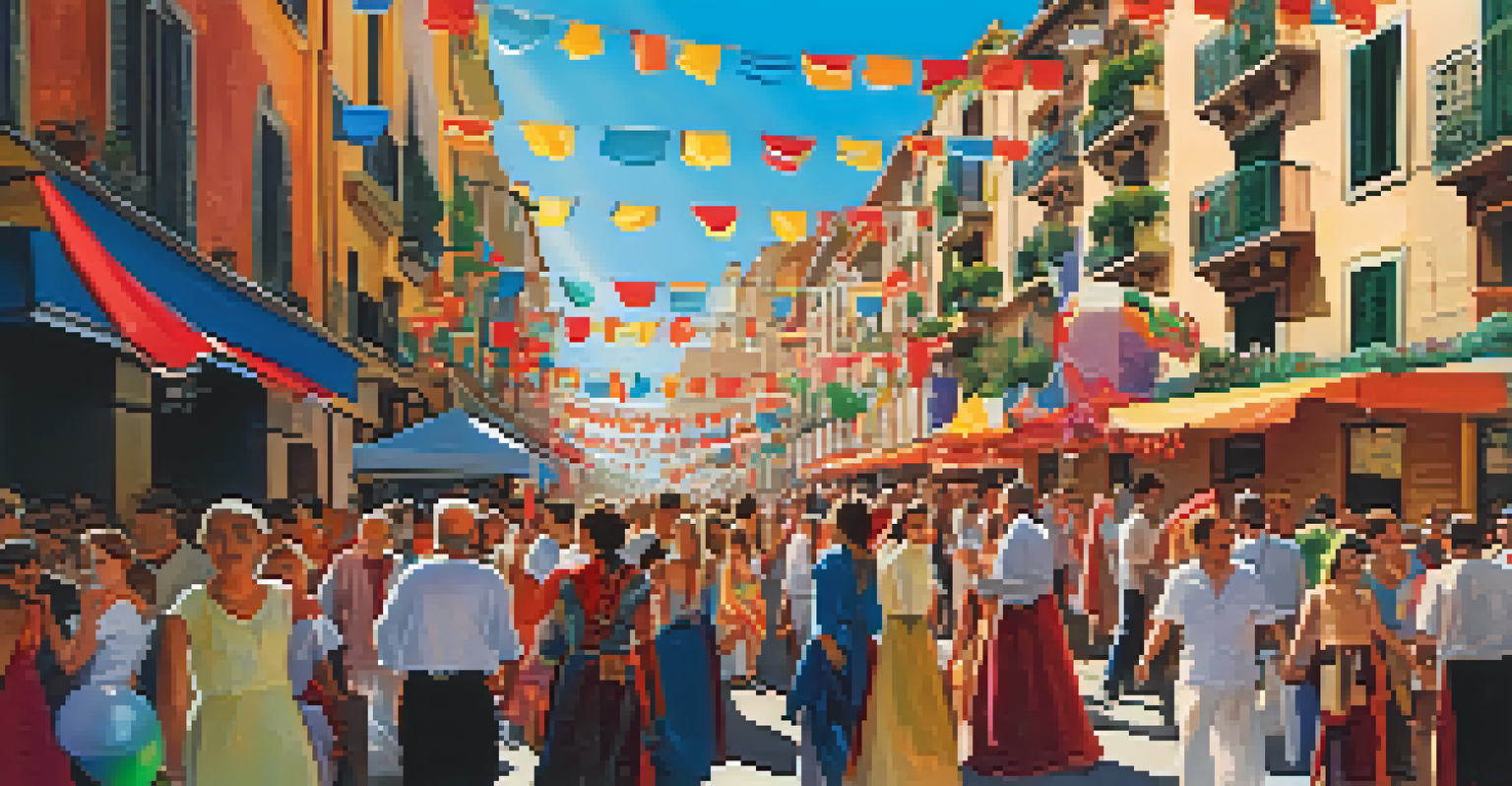Understanding the Symbolism Behind Spanish Impressionism

What is Spanish Impressionism? A Brief Overview
Spanish Impressionism emerged in the late 19th century, blending traditional Spanish themes with the innovative techniques of Impressionism. Artists sought to capture the essence of light and color, focusing on everyday scenes rather than grand historical narratives. This movement was largely inspired by the broader Impressionist movement in France, yet it retained distinct cultural elements unique to Spain.
Color is the keyboard, the eyes are the harmonies, the soul is the piano with many strings.
The movement is characterized by vibrant colors and bold brush strokes, which convey a sense of immediacy and emotion. Unlike their French counterparts, Spanish Impressionists often incorporated elements of their rich cultural heritage, including local landscapes and social life. This approach allowed them to create works that were both visually striking and deeply resonant with Spanish identity.
Key figures in this movement include Joaquín Sorolla, who is renowned for his depictions of light and water, and Ramón Casas, who captured the spirit of urban life. Their works showcase how Spanish Impressionism diverged from its French origins while retaining a sense of connection to the broader Impressionist ethos.
The Role of Light in Spanish Impressionism
Light plays a crucial role in Spanish Impressionism, serving as a primary element that shapes the mood and tone of the artwork. Artists often used natural light to depict various times of day, enhancing the vibrancy of their scenes. This focus on light not only emphasizes the beauty of the Spanish landscape but also evokes emotional responses from the viewer.

For instance, Joaquín Sorolla's beach scenes are renowned for their brilliant use of sunlight, capturing the warmth and vitality of the Mediterranean coast. By portraying light in such a dynamic way, these artists invite viewers to experience the moment as if they were there. This technique is a hallmark of Impressionism, yet its application in a Spanish context adds layers of cultural significance.
Cultural Roots in Spanish Art
Spanish Impressionism uniquely blends traditional themes with innovative techniques, showcasing local landscapes and social life.
Additionally, the interplay between light and shadow in Spanish Impressionism often symbolizes deeper themes, such as the passage of time or the contrast between tradition and modernity. This adds a philosophical dimension to the artwork, encouraging viewers to reflect on their own experiences and perceptions.
Color Symbolism in Spanish Impressionist Works
Color in Spanish Impressionism is not merely decorative; it carries significant symbolic weight. Artists used color to express emotions, tell stories, and convey the essence of their subjects. For example, warm hues often symbolize passion and vitality, while cooler tones may evoke tranquility and introspection.
Art is the most beautiful of all lies.
Joaquín Sorolla frequently employed bright yellows and blues to depict the sun-soaked landscapes of Spain, creating a sense of joy and celebration. In contrast, darker colors might appear in works reflecting societal struggles or historical narratives, highlighting the artist's commentary on contemporary issues. This thoughtful use of color invites viewers to engage with the artwork on a deeper level.
Moreover, the choice of color can also reflect specific cultural connotations. In Spanish art, red is often associated with love and bravery, while white symbolizes purity and peace. By incorporating these associations, Spanish Impressionists infused their works with rich layers of meaning that resonate with viewers familiar with the cultural context.
Themes of Nature in Spanish Impressionism
Nature is a recurring theme in Spanish Impressionism, serving as both a subject and a source of inspiration. Artists often depicted the breathtaking landscapes of Spain, from sun-drenched beaches to lush gardens. These natural settings not only showcase Spain's diverse beauty but also reflect the artists' emotional connections to their surroundings.
The portrayal of landscapes in Spanish Impressionism goes beyond mere representation; it often symbolizes the artists' inner feelings and thoughts. For instance, a serene landscape might convey peace, while a turbulent sea could represent struggle or chaos. This emotional resonance makes nature a powerful vehicle for personal expression.
Symbolism of Light and Color
Light and color in Spanish Impressionism carry deep emotional and cultural significance, enhancing the artworks' narrative depth.
Additionally, the changing seasons and weather conditions depicted in these works often symbolize the passage of time and the cycles of life. This connection to nature invites viewers to reflect on their own experiences and emotions, creating a shared understanding that transcends cultural boundaries.
The Influence of Spanish Culture on Impressionist Symbolism
Spanish culture profoundly influenced the symbolism found in Impressionist works, imbuing them with unique narratives and meanings. Traditional customs, folklore, and social issues often served as backdrops for these artists' explorations of identity and heritage. This cultural lens allowed them to comment on contemporary society while celebrating their roots.
For example, the depiction of local festivals and everyday life in Spanish Impressionist art highlights the vibrancy of Spanish culture. Artists like Ramón Casas captured the essence of urban scenes, reflecting the lively social interactions of their time. These representations serve as a visual narrative of Spain's cultural identity, bridging the gap between art and life.
Moreover, the use of symbolism in these works often reflects broader themes of Spanish history, such as resilience and community. By intertwining cultural elements with Impressionist techniques, these artists created a body of work that resonates deeply with both local and global audiences.
The Legacy of Spanish Impressionism in Modern Art
The legacy of Spanish Impressionism continues to influence contemporary artists and movements. Its emphasis on light, color, and emotion has inspired a new generation to explore similar themes in their own work. This enduring impact showcases the relevance of Impressionist techniques in expressing modern experiences and cultural narratives.
Many contemporary artists draw from the symbolism of Spanish Impressionism, incorporating its vibrant color palettes and dynamic compositions into their pieces. This fusion of old and new creates a dialogue between past and present, highlighting the ongoing evolution of artistic expression. As a result, the movement remains a vital part of the art world.
Legacy Influencing Modern Art
The impact of Spanish Impressionism continues to inspire contemporary artists, emphasizing themes of identity and cultural expression.
Additionally, the exploration of cultural themes and personal identity in Spanish Impressionism resonates with today's artists, who often seek to express their own narratives through their work. This connection underscores the timeless nature of art as a medium for reflection and communication, ensuring that Spanish Impressionism will continue to inspire future generations.
Conclusion: Embracing the Symbolism of Spanish Impressionism
Understanding the symbolism behind Spanish Impressionism enriches our appreciation of this vibrant art movement. By examining the use of light, color, and cultural themes, we gain insight into the emotional and narrative depth of these works. This exploration invites us to engage with the art on a personal level, fostering a deeper connection.
As we reflect on the legacy of Spanish Impressionism, it's clear that its impact extends far beyond its historical context. The techniques and themes explored by these artists continue to resonate in contemporary art, encouraging new interpretations and expressions. This enduring relevance speaks to the power of art to transcend time and cultural boundaries.

In embracing the symbolism of Spanish Impressionism, we not only celebrate a unique artistic movement but also recognize the universal themes of human experience it conveys. As we continue to explore and appreciate these works, we keep the spirit of Spanish Impressionism alive, ensuring its place in the tapestry of art history.